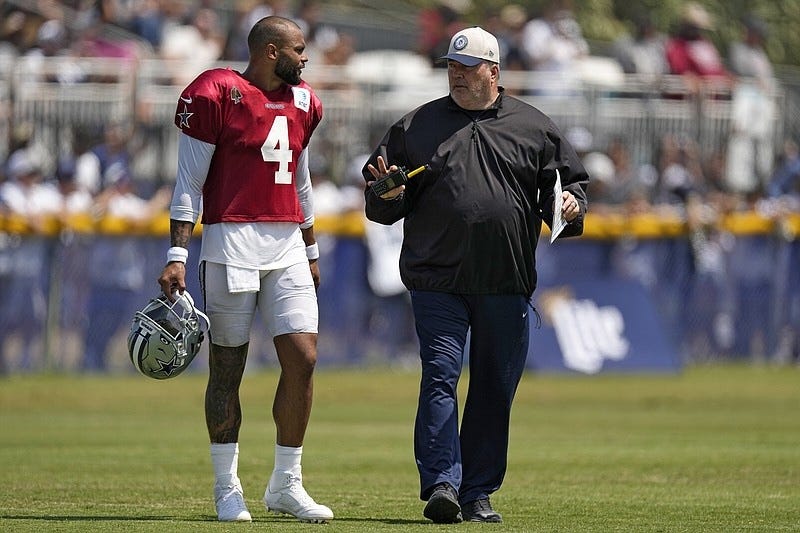301. Do You Have The Mindset Of A Quarterback Or A Coach?
There's a big difference between the mindset of a quarterback and a coach. Embracing this difference will transform your leadership. You don't even have to like football.
10x Your Team’s Productivity In < 1 Hour
Do you wish your team was more productive?
Do you wish your employees had more accountability?
👉🏽 Learn how to 10x Your Team’s Productivity in < 1 hour
On November 29, 2020 - week 12 of the NFL season - the Denver Broncos were set to play the New Orleans Saints.
There was only one problem: the Broncos didn’t have a quarterback.
Their starting quarterback, Drew Lock, had been hanging out with their backup quarterback, Jeff Driskell. Little did Drew know, but Driskell was walking around with COVID.
And just like that, both of them were out of commission.
That left the 3rd and 4th string quarterbacks. But they were also hanging out with Driskell after he tested positive for COVID, and oh, they weren’t wearing masks at the time. <gasp> Bad call, Bozos.
They were also deemed ineligible to play.
Without any other options, the Broncos called on a wide receiver from their practice squad. Apparently, this guy’s cousin’s sister’s roommate once dated the quarterback in high school, and so he was voluntold to lead the Broncos as essentially the 5th string quarterback.
There are probably worse ways to have your NFL debut, but at the moment I can’t think of any.
Needless to say, the Broncos got walloped by the Saints, 31 to 3.
This football game is why you need to care about how you act as a leader.
Acting Like The Quarterback
The quarterback is important. They’re the playmaker. They’re the guide. The quarterback is the motivation and inspiration for the team.
The great quarterback is a revered leader in our society.
But being a quarterback isn’t easy. It takes time and effort and lots of practice. It takes making mistakes and learning from those mistakes. And it takes more than a few hits that leave you breathless on the ground.
And that’s why being the quarterback isn’t always your goal.
It’s sometimes better to be the coach.
The Quarterback and The Coach Leadership Mindsets
If you haven’t clued in on this yet, I’m not talking about football. I’m talking about leadership.
There are two types of leadership mindsets: the quarterback and the coach.
[Editor’s Note: I suppose we shouldn’t mention this article]
There is a very clear distinction between the behavior of the quarterback leader and that of the coach. Lucky for you, I’m about to explain it.
Here’s what I mean:
The quarterback leader is hands-on. They are in the mayhem, they’re in the mess. The quarterback leader is making decisions by the second. They’re reacting to the conditions they see at the moment and guiding their players on their every move.
The quarterback confidently calls the shots almost all the time.
The coach is different.
The coach’s mindset is about strategy and big-picture thinking. They aren’t focused on the play as much as the game. And maybe not even the game as much as the season. They build the team, set the tone, define the vision, and then empower others to take action while they guide and mentor from the sidelines.
Behind every great quarterback is an amazing coach smiling on the sidelines. Or maybe sneering on the sidelines. My point being, the coach is on the sidelines guiding the game, not in the game.
The Tricky Transition from Quarterback to Coach
Evolving from a quarterback mentality to a coach mindset is not easy. In fact, it’s very hard.
Frankly, most people don’t have the innate skillset to do it. By the law of averages, you probably don’t have that skillset either.
But don’t worry, I gotchoo.
In fact my entire leadership team coaching practice is based on teaching leaders who act like quarterbacks to embrace what it means to have the coach’s mindset.
There are essentially 6 steps in the transition from QB to coach. They are:
1. Admit it.
Recognize and acknowledge that your team would do better and your company would grow faster if you stepped off the proverbial field and acted like a coach. The first step is admitting it.
2. Think About The Future.
Write out your long-term goals for the team/company, and write out the strategy of how you’re going to get there.
3. Delegate Authority Not Tasks.
The coach’s job isn’t about the tasks - that’s your employees’ job. Your role is to delegate authority by empowering them. Remember, a coach doesn’t tell the quarterback to throw the ball for him. That’s just the task. Instead, the coach outlines the goals of the game (winning), and the strategy in which they can best achieve that goal. They then empower the quarterback with the authority to make it happen.
4. Gain Trust Through Accountability.
Trust your team to get the job done by building a culture of accountability. You know what: you need to take this amazing course on how to 10x your team’s productivity through accountability.
5. Mentor Not Master.
Your job isn’t to master people’s jobs, it’s to mentor them so they can be better than you in their role. Have regular one-on-one meetings. Give open and honest feedback. Acknowledge the wins and provide constructive feedback in the areas for improvement.
6. Step Back and Shut Up.
You can’t always be right. You can’t always tell people what to do. People learn by doing things themselves. They learn by making mistakes. Bite your tongue. It will turn out just fine.
The Time For Quarterback and Coach
To be clear, both the Quarterback and the Coach are important leadership mindsets.
In fact, there is a time and a place where quarterback-style leadership is essential. For instance, when it comes to early-stage or startup companies, the leader needs to have a quarterback mindset.
At that stage of company growth, the leader must be in the huddle, calling the plays and adjusting on the fly.
Being a quarterback is the entire job of the startup leader. Their goal is to move the proverbial ball down the proverbial field, one yard at a time, trying different plays until they find the right product-market fit (which I suppose would be the proverbial touchdown).
But once a company has found its fit and begins to scale beyond 29 people (yes, 29 is the magic number), the quarterback leader must step into the coach mindset in order to accelerate growth.
So tell me, does your manager act like a quarterback or a coach?
The Best Leaders
Here’s the caveat to all of this: both roles are critical for the success of an organization.
For instance, in times of crisis, when business-critical decisions need to be made on the fly, it’s common for the coach to act like the quarterback. That’s ok. That’s better than ok.
The best leaders understand when to switch roles. They step in as the quarterback when necessary but they don’t stay there any longer than they have to. They trust their team to play their positions and take ownership of the game.
Both the quarterback and the coach are essential, but the trick lies in knowing when to pick up the ball and when to empower others to run with it.
As the Broncos learned back in 2020, a team without a quarterback won’t win today’s game. But a team without a coach won’t thrive into the future.
I quickly transform teams into high-performing, collaborative units. Want to learn more?
10x Your Team’s Productivity
📈 I help leaders 10x their teams’ productivity.
📲 Contact me to learn how to catapult your team’s success
Subscribe to The Best Leadership Podcast Ever
YouTube
Apple
Spotify
or your favorite podcast player.
Leading Starts With Following
⛓️ Follow me on LinkedIn
Here are some other options:
🎥 Subscribe on YouTube
⏰ Follow me on TikTok
📖 Follow me on Facebook
📷 Follow me on Instagram
🅧 Follow me on X (Twitter)







